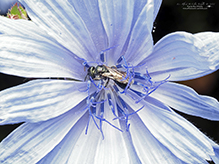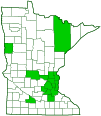spurred ceratina
(Ceratina calcarata)
Conservation • Description • Habitat • Ecology • Distribution • Taxonomy
|
|
||||||||||||||
Description |
Spurred ceratina is a small carpenter bee. It occurs in the United States and southern Canada from the East Coast through the Great plains. It is very common in the northeast, scattered and locally common elsewhere, including in Minnesota. It is a generalist feeder and pollinates a wide range of flowering plants. Adults are seen on flowers from March to October. The female is dark bluish to dark bluish-green, shiny, slightly metallic, and ¼″ to 5⁄16″ (6.5 to 8.0 mm) in length. The body is relatively robust. It is covered with pale, thin, very short hairs, but the hairs are inconspicuous and cannot be seen without magnification. The head has numerous, distinct, coarse, deep pits (punctate). The plate on the face (clypeus) is twice as wide as long. It may be entirely black but usually has a small white or ivory spot near the lower margin. The cheeks are slightly narrower than the compound eyes. The sides of the face are shiny and mostly closely and coarsely punctate but are free of punctures just below the antennae and just below the ocelli. The tongue is long and slender. The first two segments of the feeler-like structures on the lower lip (labial palps) are long and flattened. The antennae are black and have 12 segments. The thorax slopes downward gradually toward the rear. The plate on the upperside of the first segment (pronotum) is short and collar-like. It has a rounded, white or ivory lobe on each side that does not reach the plate covering the wing bases (tegula). The large plate on the middle segment (scutum) is distinctly punctate but with finer punctures than on the head. The abdomen is straight and more or less parallel on the sides then abruptly tapered at the rear. It has broad rounded ridges, somewhat like a water bottle. There are no pale markings or pale hair bands. The punctures on the abdomen are fine but distinct toward the sides and mostly absent in the middle. The wings are lightly tinted reddish-brown. The veins are reddish-brown. On the forewing, the basal vein is distinctly arched. There are three submarginal cells. The second submarginal cell is triangular and is about as high as the base is wide. On the hindwing the rear lobe at the base (jugal lobe) is short, shorter than the submedian cell. The legs have sparse pollen hairs. The third segment (femur) of each leg is dark metallic blue. The fourth segment (tibia) is darker. On the front legs the tibia has a small white or ivory spot at the base. On the front and middle legs, the tibia has a single, small, pale reddish-brown spur at the tip. The last part of each leg (tarsus), corresponding to the foot, is reddish-brown. The male is bluish-green and smaller, 3⁄16″ to ¼″ (5.0 to 7.0 mm) in length. The clypeus has a large white mark in the shape of an inverted T that covers most of its surface. The upper lip (labrum) has a rectangular white or ivory mark in the middle. The cheeks are much narrower than the compound eyes. The antennae have 13 segments. The femurs on the hind leg is expanded and has a triangular projection in the middle. The width of the femur at this point is about half the length of the femur. The tibiae on the front legs does not have a white or ivory spot. Spurs on the legs are pale yellowish. |
Size |
Female: ¼″ to 5⁄16″ (6.5 to 8.0 mm) Male: 3⁄16″ to ¼″ (5.0 to 7.0 mm) |
Similar Species |
Habitat |
|
Ecology |
Season |
March to October |
Behavior |
|
Life Cycle |
The female burrows through the soft cells (pith) in the center of a broken twig. The twig must be broken, burnt, or otherwise damaged, because she cannot chew through the hard outer layer. She overwinters in the burrow. The following spring, she continues burrowing, creating a long tunnel. She lays an egg at the end of the tunnel, provisions it with pollen, and seals it off with stem shavings from the inside of the burrow, creating the first cell. |
Larva Food |
Pollen |
Adult Food |
Nectar from a wide range of flowers |
Distribution |
||
|
Sources |
|
| 9/12/2024 | ||
Occurrence |
||
Very common |
||
Taxonomy |
|
Order |
Hymenoptera (Ants, Bees, Wasps, and Sawflies) |
Suborder |
Apocrita (Narrow-waisted Wasps, Ants, and Bees) |
Infraorder |
Aculeata (ants, bees, and stinging wasps) |
Superfamily |
Apoidea (bees and apoid wasps) |
Epifamily |
|
Family |
Apidae (honey bees, bumble bees, and allies) |
Subfamily |
Xylocopinae (carpenter bees) |
Tribe |
Ceratinini (small carpenter bees) |
Genus |
|
Subgenus |
Zadontomerus |
Subordinate Taxa |
|
|
|
Synonyms |
|
Zadontomerus calcaratus |
|
Common Names |
|
spurred carpenter bee spurred ceratina wide-legged little carpenter bee |
|
Glossary
Clypeus
On insects, a hardened plate on the face above the upper lip (labrum).
Femur
On insects and arachnids, the third, largest, most robust segment of the leg, coming immediately before the tibia. On humans, the thigh bone.
Gena
In insects: The area between the compound eye and the mandible; the cheek. In birds: The area between the the angle of the jaw and the bill; the feathered side (outside) of the under mandible. Plural: genae.
Palp
Short for pedipalp. A segmented, finger-like process of an arthropod; one is attached to each maxilla and two are attached to the labium. They function as sense organs in spiders and insects, and as weapons in scorpions. Plural: palpi or palps.
Pith
The spongy cells in the center of the stem.
Pronotum
The exoskeletal plate on the upper side of the first segment of the thorax of an insect.
Punctate
Dotted with pits (punctures), translucent sunken glands, or colored spots of pigment.
Scutum
The forward (anterior) portion of the middle segment of the thorax (mesonotum) in insects and some arachnids.
Tarsus
On insects, the last two to five subdivisions of the leg, attached to the tibia; the foot. On spiders, the last segment of the leg. Plural: tarsi.
Tegula
A small, hardened, plate, scale, or flap-like structure that overlaps the base of the forewing of insects in the orders Lepidoptera, Hymenoptera, Diptera, and Homoptera. Plural: tegulae.
Tibia
The fourth segment of an insect leg, after the femur and before the tarsus (foot). The fifth segment of a spider leg or palp. Plural: tibiae.
Visitor Photos |
||
Share your photo of this insect. |
||
This button not working for you? |
||
Alfredo Colon |
||
 |
 |
|
MinnesotaSeasons.com Photos |
||
|
||
|
||

Slideshows |
|

Visitor Videos |
||
Share your video of this insect. |
||
This button not working for you? |
||
|
Other Videos |
||
|

Created: 5/21/2023 Last Updated: © MinnesotaSeasons.com. All rights reserved. |



